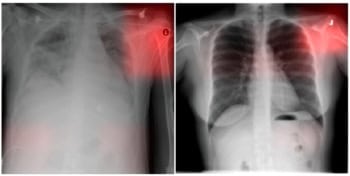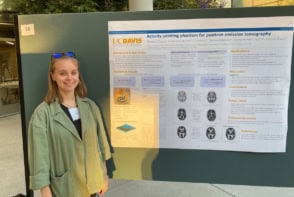
A new type of nanoparticle could allow patients to be imaged in six different ways with an injection of just one contrast agent, reports an international research team. If put into clinical use, the technology could give doctors the ability to combine the strong points of a number of imaging techniques, providing a clearer overall picture of patient organs and tissue.
Many ways and means
The nanoparticles – averaging 74 nm in diameter – comprise a core surrounded by a porphyrin-phospholipid (PoP) wrapper. Each part has properties that facilitate different imaging modes. The core component fluoresces blue when struck with near-infrared light, allowing imaging with the potential for deep-tissue penetration. In addition, the core’s ytterbium component, which is dense in electrons, enables detection by CT scanning. The outer PoP shell has biophotonic properties that make it suitable for use with both fluorescence and photoacoustic imaging. At the same time, the copper affinity of the porphyrin wrapper allows the nanoparticles to be easily coated in radioactive copper-64 for the purposes of PET and Cerenkov-luminescence imaging. The team initially tested each imaging method in vitro and subsequently in a turkey breast to determine the level of signal attenuation with tissue depth. Turkey breast was chosen as a medium comparable to that of human breast tissue, as lymph-node mapping is a current challenge in the assessment of breast cancer. The nanoparticles were then used to image the lymph nodes of live mice, demonstrating the potential of this approach.
Multiscale imaging
“Photoacoustic imaging provides information about endogenous blood vessels, while CT provides information about local bone structure,” says team member Jonathan Lovell, a biomedical engineer at the University of Buffalo in the US. The CT and PET scans were seen to afford the deepest tissue penetration, while fluorescence imaging provided additional information on the uptake of the nanoparticles into cells.
Along with the nanoparticles’ convenient compatibility with the different imaging methods, the researchers also point out that their nanoparticles are both inexpensive and simple to manufacture in comparison with other contrast agents. “Another advantage of this core/shell imaging contrast agent is that it could enable biomedical imaging at multiple scales, from single-molecule to cell imaging, as well as from vascular and organ imaging to whole-body bioimaging,” adds Guanying Chen of the University of Buffalo’s Institute for Lasers Photonics and Biophotonics and the Harbin Institute of Technology in China.
All in one
An imaging machine capable of performing all six scans at once does not currently exist, but the researchers are optimistic that devices capable of exploiting some or all of the nanoparticles’ potential will soon be developed. “Creating a higher-order integrated scanner is not a simple task, but luckily there has been a lot of research and development into just that topic recently,” says Lovell, noting that integrating just some of the six methods – such as the optical techniques, for example – might provide a simpler device that would still be suitable for clinical applications.
Tumour mapping
David Cormode, a radiologist from the University of Pennsylvania who was not involved in the work, is impressed with the nanoparticles’ unique potential as a flexible contrast agent. “I look forward to future work where the agent is used for targeted imaging,” he says, while noting that “safety and excretion will have to be studied prior to translation to patients”.
In addition to confirming the suitability of the nanoparticles for clinical use, the team is also seeking additional applications for the technology. One avenue of investigation would involve the addition of a targeting molecule to the surface of the nanoparticles, allowing them to be taken in by cancer cells to allow better mapping of tumours.
The work is published in Advanced Materials.
- Check out the Physics World 2015 Focus on Medical Imaging



